The SKTCHD AWRDS: The Comics of 2023
Much to the contrary of many a pundit these days, 2023 was actually an incredible year in comics, one where you could find superb works in every format, from graphic novels and webcomics to manga and single issues. Yes. Even, single issues. It was an exciting year because of that, and because how this meant you never knew when your next favorite comic might hit and where it might come from.
So, with that in mind, this article will dig into the Comics of 2023 portion of The SKTCHD AWRDS, as I reveal my favorite comics from the year that was. In case you missed it, my Creators of 2023 led this entire endeavor off, but today, 25 titles will earn my vaunted, prestigious SKTCHD AWRDS. Each release has been given one of these totally real, absolutely not made up awards for a hyper specific reason, with the most crucial one being that I loved it. To ensure it all adds up in the end, though, I created rules for how I determined the winners, because I am nothing if not driven by rules. Those were:
- These aren’t the “best” comics of the year. I don’t feel as if I can speak to that. I can speak to my favorites, and precisely why they stood out. That’s what this is.
- If it was a single-issue title, I only considered those if it had released a minimum of three issues (or three issues worth of pages) by the time my list was complete.
- This only considers work released in 2023, but if I read it in single issues (or some other format) in 2022 and before, it didn’t factor in to my process. Apologies to all trade paperbacks released in 2022, basically, as well as some graphic novels collecting work released in another form!
That’s it! Beyond those rules, anything goes, as long as the comics are great! So let’s get to celebrating those award winners, ordered alphabetically by title (not including articles at the beginning of the title, like “the” as just one example).
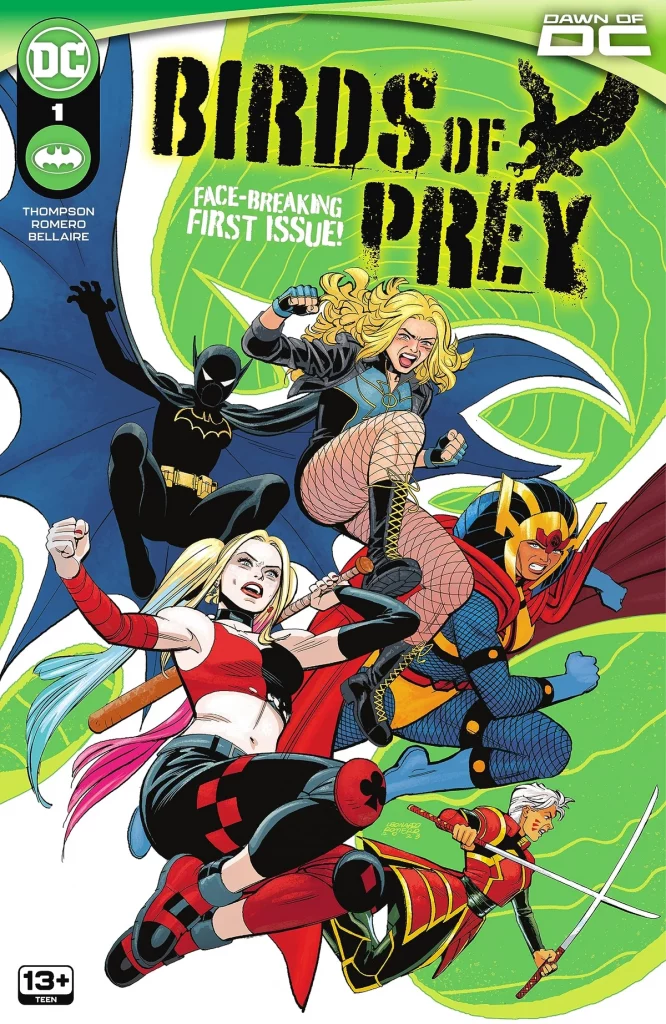
The Reprise Award: Birds of Prey
Why it stands out: Kelly Thompson, Leonardo Romero, and Jordie Bellaire’s Hawkeye run was a good one. It was also one that felt cut short to some degree, as if it had so much more to give than the 16 issues it lived for. But over that span, it was easy to see that Thompson, Romero, and Bellaire had an easy chemistry, carrying a rare match of gifts and abilities that helped elevate the project and each other along the way. It was hard not to wonder “What could have been if they were given more time to work together?” if only because of how simpatico that group was together. Alas. Thus is the cruel nature of comics, in which a team is gathered for a fleeting moment, never to be paired together again.
Until 2023 at least! When the squad was reunited with a new volume of Birds of Prey!
Honestly, I knew as soon as word hit that this trio was back together again, this time with letterer to the stars Clayton Cowles alongside them, that the potential for this project was high. They meshed well already, and each had only sharpened their skills in the years since. More than that, Birds of Prey had been off the table for a minute, and the unconventional mix of characters — a classic leader in Black Canary with newcomers like Zealot and Maps Mizoguchi featured prominently within — gave this project a more tailored feel. It was created with intent, and one that meshed well with the strengths of its creators. On potential alone, I thought this would be a contender.
The actuality was so much more. While it’s a mere four issues into its run, those four issues contain as much fun and action and exceptional character work and interpersonal relationship building than basically any other superhero title on the stands. Like its exemplary artist, Birds of Prey has a unique air of being a throwback that balanced multiple layers of character and plot while being a fully modern take on superheroes. It is, simply put, the most joyous superhero comic these days, and a fulfillment of the promise this team showed on Hawkeye all those years back. Of course, I sort of telegraphed that this title would appear here last week, as Thompson, Romero, and Bellaire all were in my Creators of 2023 list. But that’s just how welcome this return was, and how well this creative team delivered on the promise of this project and their collaboration.
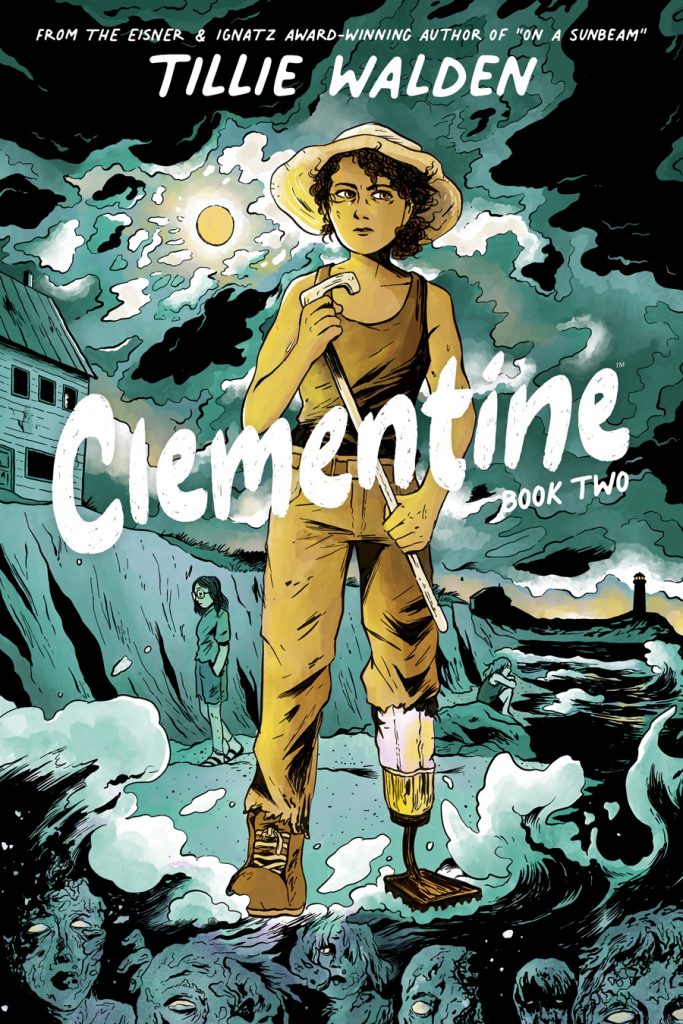
The Tough Times Award: Clementine Book Two
Why it stands out: The Walking Dead as a whole, but maybe even Clementine in specific, have a unique challenge built into them. That’s that the nature of these stories are so miserable that it can be tough to give readers something to hold onto. How do you create a connection when all the varying characters know is loss?
That core idea is something cartoonist Tillie Walden wrestles with in the graphic novel series Clementine, which continues the story of the lead from the Telltale The Walking Dead video games. Those games are a lot to live up to, as they feature some of the strongest writing and character work in video game history, to say nothing of the hordes who are deeply invested in Clem’s journey. The good news is, it’s clear Walden thoroughly understands the character, and this year’s Clementine Book Two adds to the overwhelming pile of evidence that this is true. This series, and this book, is about Clementine and her friends finding reasons to survive and to hope for a better tomorrow, despite all evidence suggesting otherwise. And by giving Clem a reason to trust again, things to care about, and a possible brighter future — albeit through a whole lot of misery! — it’s impossible to not get deeply invested in this journey.
Walden’s one of the most gifted cartoonists in the world, and all of her strengths are on display. The exemplary character work. The thoughtful visual storytelling. The smart pacing. We’re given a masterclass of cartooning in this book, one that helps ground and elevate this story at the same time. While some readers were hoping for this series to be a remembrance of Clementine’s past, Walden ensured it’s more than that, something that’s designed to help the character imagine a future that’s better than the life she’s lived so far. And that’s where that connection I mentioned earlier is fostered. Sure, it’s tough times for Clem, as it has been throughout her life. But Walden dares to imagine the things it would take to make the character want to push through all that and try to find something more for herself. In short, it’s about the same things as the video game series, but wholly distilled through the prism and skills of Walden. What a gift it is for readers, and for fans of the Telltale series.
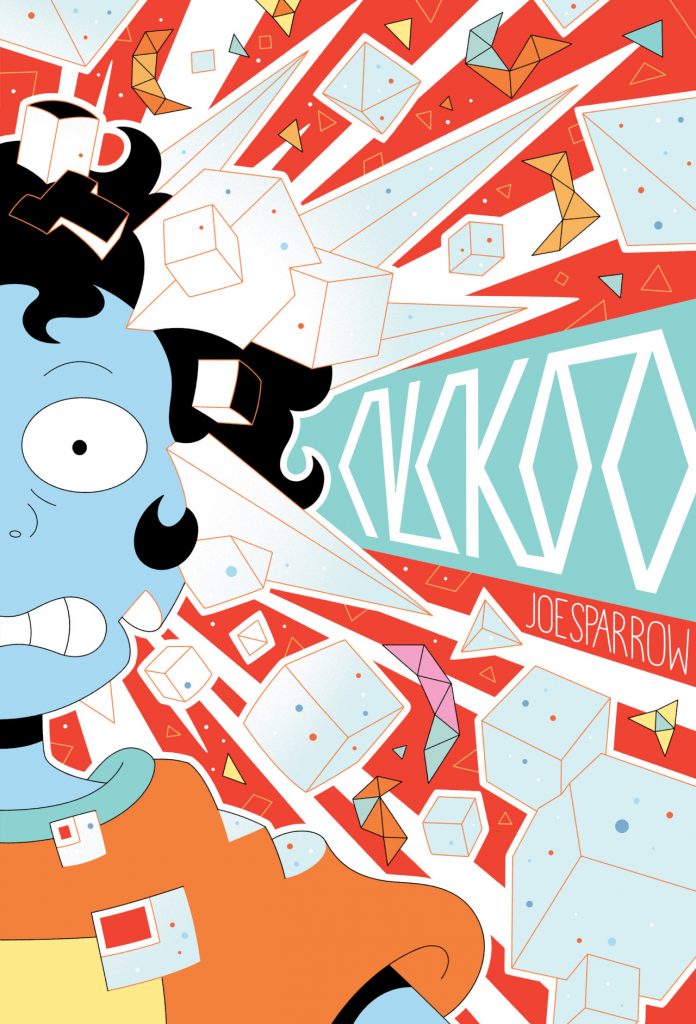
The Rising Star Award: Cuckoo
Why it stands out: Joe Sparrow’s ShortBox graphic novel sounds like a pretty common modern sci-fi tale on the surface. It’s about a young person discovering something unexpected from space, developing powers shortly thereafter, finding someone else who did the same, and then contending with what comes next from there. That’s basically the plot of the movie Chronicle, minus the found footage elements. That’s an interesting idea, but territory we’ve tread on before, or at least so it seemed.
The reality is, it’s so much more than that, and also so much less in a very good way. Sparrow isn’t interested in heroes and villains or battles in the sky between the gifted youngsters in the story. Cuckoo instead focuses on the internal, using these powers and this tale as an exploration of growing up as someone who just doesn’t fit in, and a path to discovery that leads to gaining understanding of yourself. The story can still get into some big places, but as much as it’s about powers and the origins of those, it’s also about a person finding themselves in the most extraordinary of times, and what they do when faced with that moment. And Sparrow nails each and every beat, both with his writing and his exemplary cartooning.
Cuckoo begins and ends with parallel panels and imagery, and it’s a lovely way to open and close the book, if only because the whole story feels poetic and wonderful in an unusual way. That it achieves these heights with its roots in well-tread territory speaks to the gifts of the cartoonist behind it, someone who showcases within these pages that this isn’t just a great book, but the beginning of an exemplary career in making comics, if Sparrow wants it. While the cartoonist has displayed this before in works like the graphic novella Homunculus, Cuckoo finds Sparrow reaching a new level, revealing that like the book’s lead Dorothy Weaver, he’s a rising star — and someone who is starting to understand that.
I talked with Sparrow about Cuckoo on Off Panel around the time of its release, as we discussed his career and the graphic novel on the podcast.
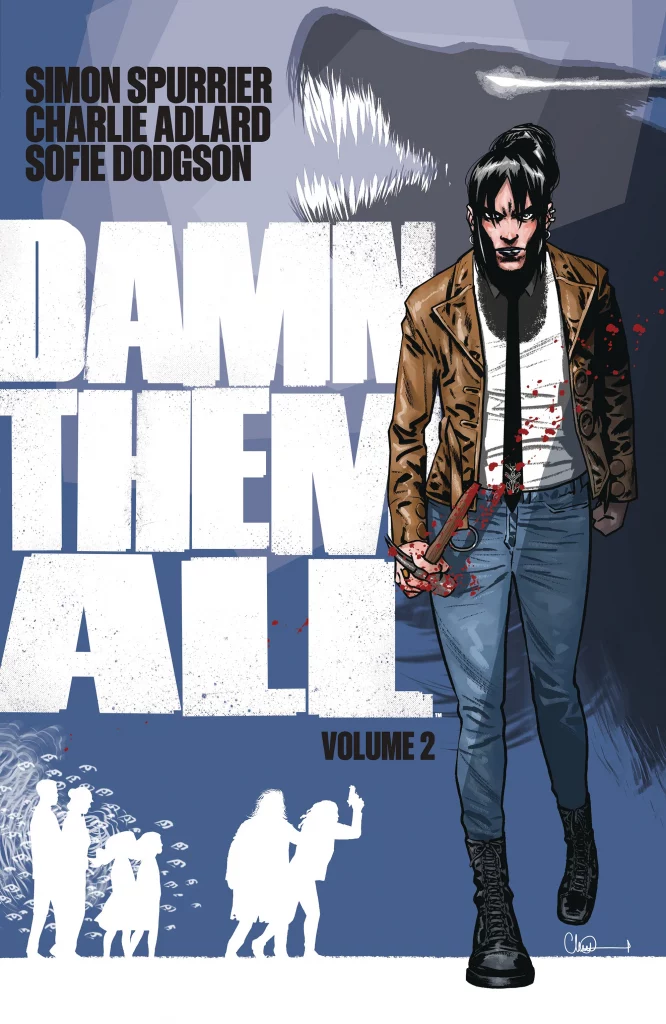
The Classic Misdirection Award: Damn Them All
Why it stands out: Damn Them All is a series is about Ellie Hawthorne, an “occultist-for-hire,” and what happens after her uncle — one of the greats in the field — dies, and all of a sudden 72 demons are loosed upon fair London. On the surface, that sounds like what could be a simple idea. Hawthorne cleaning up the mess, going around exorcising those demons and getting everything back to the status quo. It’s a nice “freak of the week” structure, like any number of procedural TV shows. But this is Si Spurrier, Charlie Adlard, Sofie Dodgson, and Jim Campbell we’re talking about, so instead of taking the obvious route, they go down a much more fascinating one, turning Damn Them All into one of the most absorbing and exciting reads of the past couple years in the process.
The thing that impressed me the most about this book is how everything about it is a twist on expectations, but it doesn’t do that in a way that feels like it’s just messing with you. You think you know what it’ll be, and what the demons will be like, and that everything will be black and white, and that everything will be clean and tidy in the way these stories often are. But instead, this story lives in the murky grays of the world, where no one is purely right and no one is purely wrong, and it constantly has readers on their toes because of it.
It’s also impressive because of the gifts of the people behind it. I truly believe this is Adlard’s finest work yet, which is really saying something after nailing something like 188 issues of The Walking Dead. Dodgson’s colors are unreal, and something that helps elevate Adlard’s art to the aforementioned levels it reaches. Campbell kills it, as he always does. And Spurrier is at his very best here, turning an impressively dense single-issue read into an entertaining blockbuster and a straightforward narrative into one of complexity and surprise. Only a few issues remain, and I have no idea what’s yet to come, if only because this team has so wonderfully misdirected me as a reader throughout its run. But while I’m unsure as to what the plot holds for me as a reader, there’s one certainty of what awaits me: it’ll be of the highest of quality, and something I’ll treasure in rereads going forward.
I talked with Spurrier about this book, amongst other things, on Off Panel recently. It’s worth a listen if you’re a fan of the series.
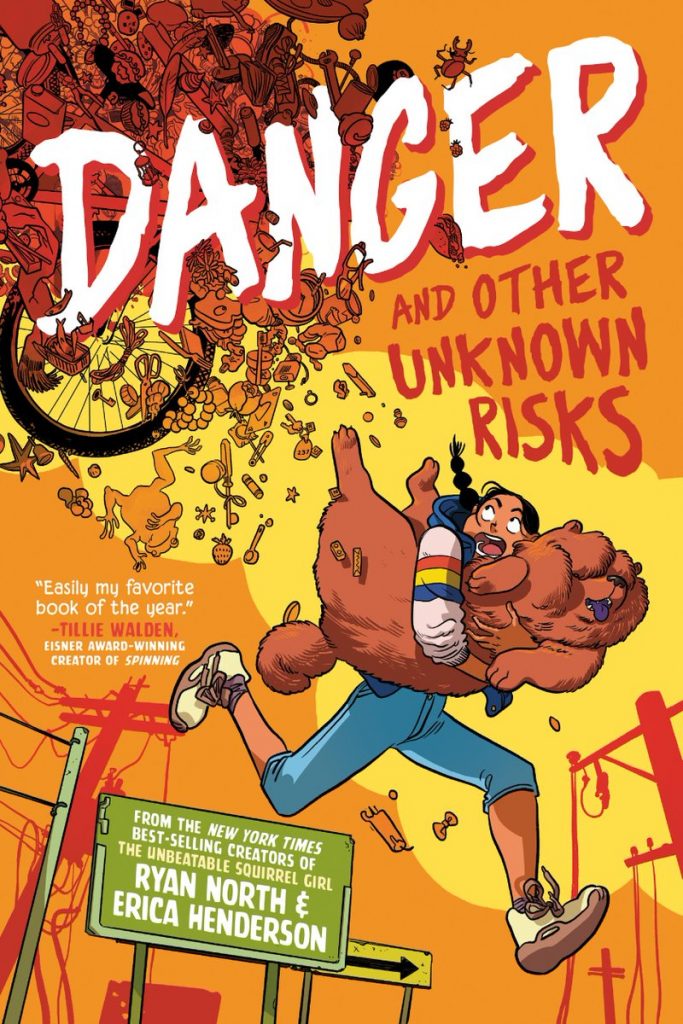
The Deuce Bigalow Award: Danger and Other Unknown Risks
Why it stands out: I’m going to be honest. Deuce Bigalow: Male Gigolo is not a good movie.
It really isn’t.
And yet, whenever I think of Erica Henderson and Ryan North’s Danger and Other Unknown Risks, it’s what my mind goes back to. Early in the pages of this graphic novel about a chosen one trying to save the world after Y2K leads to its sort of destruction when the clock striking midnight brings magic to the world, the book’s lead Marguerite de Pruitt’s Uncle Bernard instructs the clerk of a store to do something valuable with his remaining time, with one of his suggestions being to go see Deuce Bigalow in theaters. And that moment always struck me, and it did so for multiple reasons.
One is that this moment proves to be a clue of the ultimate nature of the story, as bizarre as that sounds. 1 Another is because it’s a hilarious reference that’s wildly unexpected. Lastly, it’s because that movie is strangely a good thematic parallel to Marguerite’s journey with her talking dog pal Daisy and her eventual teammate Jacin. Deuce Bigalow is a story about a person in an extraordinary situation who learns that kindness and friends are the only way to get through said extraordinary situation. 2 That’s…kind of exactly the same thing that Marguerite learns! This comic is a send-up of the Chosen One concept that also perfects it in its own way, and emphasizes that no matter how powerful or destined an individual is, the only way you’ll win the day is together, something Deuce would nod his head at.
Is all this a reach? Maybe! But it’s also something that emphasizes just how remarkable this book is. That I can legitimately get this much out of an offhand comment by a man that’s shopping for doomsday in the book’s prologue speaks to how exemplary the team of Henderson and North really is. Danger and Other Unknown Risks is funny and smart and charming and thoughtful in the ways that we already would have expected from them. But given room to roam, they give this book layers that endlessly delight and reward readers who are enamored with its tale. Pair all that with Henderson’s truly wonderful art — everything she does within these pages is a big part of the reason she earned my Artist of the Year award last week — and you have a graphic novel that fulfills the promise it had when it was announced, and then some. It’s much more than a Deuce Bigalow reference, but it’s also not, and I swear I mean that in as complimentary of a sense as humanly possible.
I talked with Henderson and North about this book on Off Panel back in April. Surprising no one, I called that episode Deuce Bigalow as well.
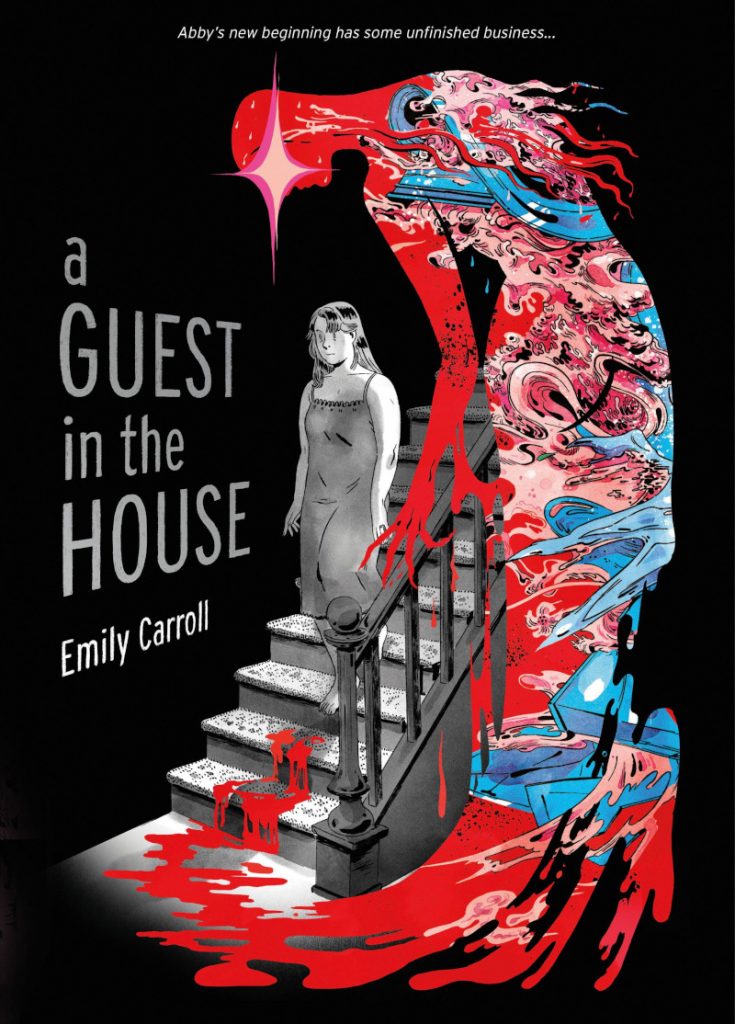
The Ambiguity Award: A Guest in the House
Why it stands out: Emily Carroll’s A Guest in the House is a great comic in the way that all of Emily Carroll’s comics are great. You can’t ask for one to be much better looking than what you get from Carroll, and that isn’t simply because of the art. While Carroll’s storytelling is remarkable (as per usual) and her color choices (black, white, and washes for the main story and a rich mix of hues when dreams and otherworldly elements enter the tale) astonish and her character work slays (as it always does), the cartoonist’s ability to integrate her lettering into the story in uniquely effective ways is as good as ever. It helps give this book an atypical feel that resides within a space Carroll solely owns. In a lot of ways, there aren’t even elements of Carroll’s work; it’s just complete pages that are only finished when all aspects are together and finalized.
This book is also scary in the way we have grown to expect from the cartoonist. No one plays that card better than she does, and A Guest in the House lives up to our expectations for her. But where things really impress is when the horror and artistic elements meet at the intersection of interpretation. While everything on the page is remarkable, a key reason this graphic novel soars is because of what it drives the reader to do. Its ambiguous nature — namely, our reading of the ending and what the title actually means, at least for me — fuels and rewards rereads while making it that much more scintillating, as your first read makes you immediately flashback to everything you just read like Chazz Palminteri at the end of The Usual Suspects. That’s important because if you told us exactly what happens in a scary story, it’s scary once and that’s that. But Carroll asks us to consider the possibilities. That makes this so much more interesting — and scarier, too.
At its core, A Guest in the House is a study of domesticity and the weight of history and curiosity, and an exploration of a character who is doing some exploring herself when faced with an extraordinary situation. That in of itself is enough ammunition for Carroll to pump out a classic. But by layering ambiguity on top of it all, Carroll made this one so much more, and another hit in a library of works entirely made of those.
Earlier this year, Carroll joined me on Off Panel to discuss this book and her career. If you enjoyed the book, I suspect you’ll enjoy our chat, as well.
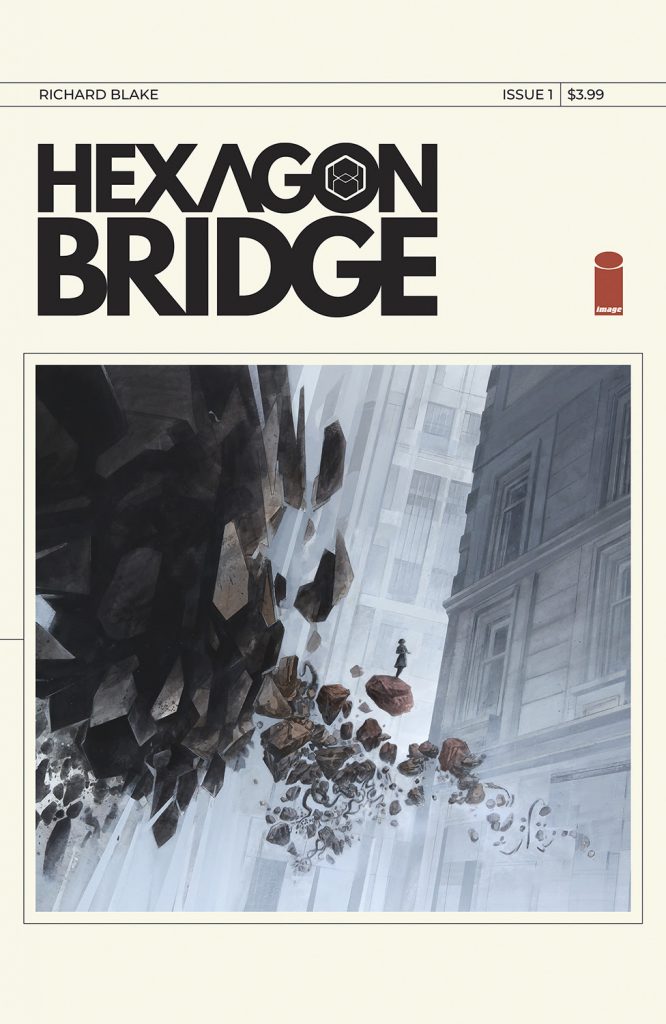
The Fully Realized Award: Hexagon Bridge
Why it stands out: Crafting a debut can be a difficult thing for a comic creator, especially if you’re doing everything yourself. It’s difficult enough to just write or draw or color or letter a comic if you’ve never done it in a published release before. To take all those tasks on yourself? That’s even more challenging. It asks you to learn on the job and in the public’s eye, figuring out the right decisions through the mistakes you invariably make on the page. It’s tricky!
That’s why Richard Blake’s Hexagon Bridge is so impressive. Everything about it, from obvious roles like writing and art to the design of the entire project, is by Blake, and each feels like an aspect from a magnum opus by a seasoned veteran rather than a first-time creator. Hexagon Bridge shouldn’t be a debut; it should be the tenth release of someone who has made a million mistakes along the way. But Blake is a fully realized talent, someone whose careful balance, thoughtful pacing, and intelligent approach has resulted in a work that’s unlike anything else on the stands in all the best ways.
I’ve said this before, but I knew I wanted to read this comic as soon as I saw its first cover. It was a hook, acting as an easy draw for a curious reader. What sometimes happens when a cover is such an effective draw is it ends up disappointing, as the cover promises something the interiors can’t live up to. That isn’t what Blake did. Instead, its first cover proved to be just the first step in a series that matches the mystery and curiosity and keen sense of design and lovely art of its introductory image. For most, living up to that promise is a difficult path, a weight that hangs around your neck as you sit and put the actual comic together. For Blake? It’s just another day at work, as he brings his first ever comics project to life with the ease of a seasoned vet. It’s impressive as hell, and just makes me excited for what’s next from the cartoonist.
I talked with Blake about this series on SKTCHD, as we dug into his path to this comic and how he’s making the magic happen in its pages.
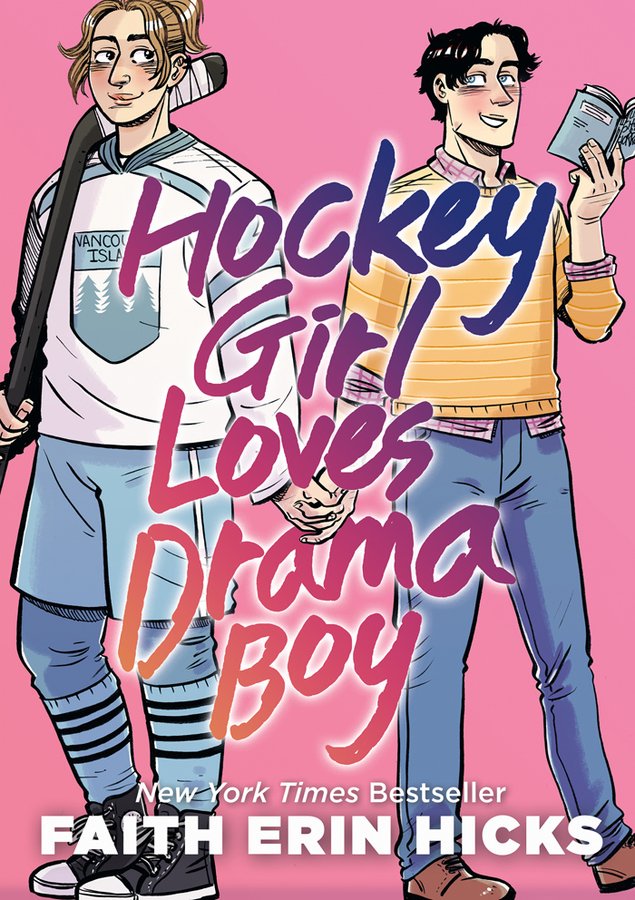
The Always Building Award: Hockey Girl Loves Drama Boy
Why it stands out: It’s no surprise to veteran SKTCHD readers that I’m a bit of a fan of Faith Erin Hicks. The veteran cartoonist has a 100% hit rate in my book, with each and every graphic novel she’s published endlessly delighting me with all the hallmarks we know and love her comics for. You know, old standards like her remarkable character work, whether that’s drawn or written, the big emotions and humor she’s always able to bring to the page, or her rare gift at making relationships sing. It’s difficult to like a comic from Hicks, if only because the only real option is to love them.
That’s not to say she’s always resting on her laurels. In fact, I’d argue you can see steady improvement throughout her career and across her projects, even if much of it is subtle. But you can especially see it in something like her latest graphic novel, Hockey Girl Loves Drama Boy. Its premise and setup is fairly simple. The title explains it well. It’s about the relationship between a girl who excels at hockey and a boy who lives for drama (of the acting variety). We’ve seen this kind of thing from Hicks before, and she nails so much of it as she typically does. But little things just feel slightly better than usual, whether it’s her even more confident than usual pacing — I talked about a shower scene from this book previously, but the cartoonist’s choice to take a breath and show the book’s co-lead Alix when she’s alone and at peace is brilliant — the complexity of some of the relationships, or her ability to create a villain that yours truly was able to fully loathe for the first time.
None of it is significantly different than what we’ve come to expect from Hicks, it’s just all of it is slightly sharper and richer than before. It helps turn Hockey Girl Loves Drama Boy into one of the strongest works of Hicks’ career, and a fine addition to a swelling library of quality graphic novels.

The Better Late Than Never Award: Impossible People: A Completely Average Recovery Story
Why it stands out: Over the past couple years, I’ve come to realize that autobio comics are some of my absolute favorites, and consistently so. There’s something magical that can happen when a cartoonist turns their lens on themselves, especially when they’re someone who is equal parts funny, honest, and unrelenting. When that’s done well, a book has an immense ceiling. Julia Wertz’s Impossible People: A Completely Average Recovery Story is a perfect example of this. The veteran cartoonist has long impressed readers with her work, and for good reason. It’s clear she’s a heck of a talent. But this was the first book of hers I’ve read, and each and every page was a reminder to me of what a fool I’ve been until now.
That’s at least in part because Wertz herself constantly reminds us of what a fool she can be too. While the cartoonist described this journey as a “completely average recovery story,” there are two main things that make it much more than average. One is Wertz’s gifts as a cartoonist, as she can tell a story like nobody’s business, delivering on moments both humorous and emotional with equal aplomb. The other is that unlike with many of these stories, Wertz does not give herself any breaks. This is a story that shows everything about her journey, warts and all. Sometimes that results in moments of deep sympathy. Other times you can’t help but shake your fist at her decisions. Other times you find yourself laughing so hard your wife wonders whether you’re okay.
You run the emotional gamut while reading this book. That’s where Wertz’s gift truly lies. Nothing in this graphic novel leaves you emotionless. You’re always feeling something as a reader. And that can be difficult thing for a cartoonist to do. Few cartoonists I’ve ever read are better at mining the extraordinary from the ordinary than Wertz, as she nails every panel and page of this remarkable yet completely average story. Impossible People is a triumph, and likely just a gateway to a lifetime of exceptional works from this great cartoonist for yours truly.
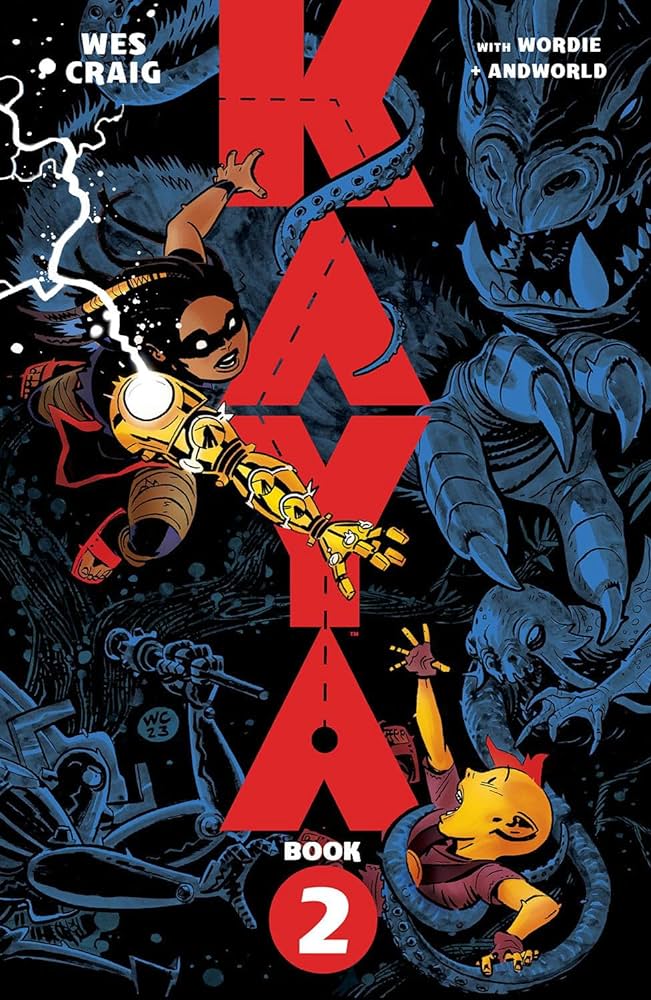
The Storytelling Award: Kaya
Why it stands out: While Wes Craig was exempt from my Creators of 2023 awards because his sole work from the year was destined to win an award this week, I don’t want to let that discount his efforts this year. Kaya’s a great comic, one that explores a chosen one narrative that recalls comics like Bone, Frank Frazetta’s Conan paintings, and some of Hayao Miyazaki’s strongest work. It’s an inventive story, one that feels like a whole world come to life in a real way. It has memorable characters, some of whom are lizard people with exemplary hair. But none of those things are the reason Kaya sticks with me as much as it does.
To be honest, it really just comes down to Craig’s storytelling.
No one.
No one.
Is better at telling a visual story in single-issue comics right now.
I mean that sincerely. When you read Kaya, it’s like seeing a maestro at work, as Craig conducts a symphony of emotion and action and bizarre worlds and so much more through his art. Every decision on the page is a careful choice made by its creator, one designed and tailored just for that moment. And he does it dozens of times an issue. Sometimes even dozens of times on a page! Nothing he does is boilerplate or standard issue. Kaya is Craig unleashing everything he’s wanted to do in comics in one space, and it results in an endlessly appealing read with a whirring energy and enough weight behind it that you truly feel it when he decides to punch you in the gut.
Kaya is a good comic for a lot of reasons, and it’s one I’m excited to see complete and collected, because I think it has the potential to find a much more expansive audience at that point. But it’s a great comic because of the fearless decisions made by its genius creator. Craig has proven himself as one of the rare cartoonists who can keep up with the pace of single-issue comics and not let his work suffer in the slightest in the process, which is a rare thing indeed, just like Kaya is as a series.
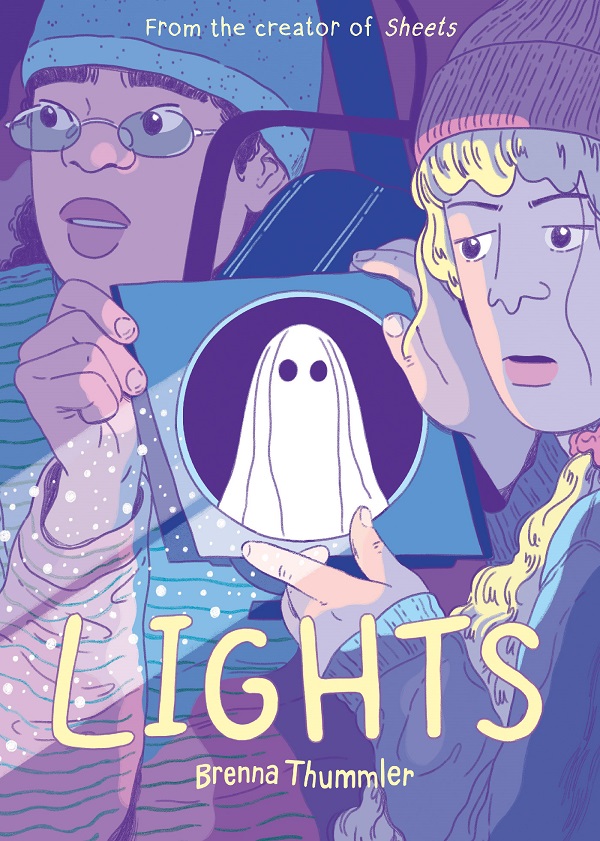
The Closing Loops Award: Lights
Why it stands out: There are a lot of incredible things about Brenna Thummler’s Sheets trilogy, but one relates to something that hit me after I finished its first entry, the aforementioned Sheets. My thought was, “Wow, that was an excellent one-off graphic novel!” I never expected it to have a sequel, if only because it felt like a complete story, one with a satisfying beginning, middle, and end. Sure, it could continue in the same way almost any story could, but it didn’t feel necessary, nor did I see a clear path.
And then Thummler released a follow-up with Delicates, and it was incredible as well, building on the story in ways I couldn’t have imagined it heading in. And again, I thought, “That was a great two book series! I’m glad I read this now complete story.” You can guess what happened next. Another book was announced in Lights, the finale to this trilogy. Trained by Delicates, I knew to expect greatness, especially considering the fact — not an opinion, but a fact — that Thummler’s one of the rising stars in the comics space. But I had no clue as to what I should expect from this book, nor did I have any understanding as to what a complete version of this story even looked like.
Thankfully, Thummler’s a much wiser person than I, as Lights delivers everything I loved about this series — the remarkable character work, the lovely interstitial illustrations that connect chapters and slow the pace, the emotional complexity, etc. etc. — but with a storyline that truly closes the loop on Marjorie Glatt, Wendell the ghost, and everyone else’s journey in the series. Thummler dared to imagine what an actual ending for these characters looked like, and then brought it to life in a way that surprised and delighted this reader. This series has always been a coming-of-age story, one with more than a tinge of sadness to it. But Lights proves to be the book that allows everyone to come to terms with what they need to do in the present to make the future right for themselves and the people around them.
I used this word before, but it’s worth reiterating: Thummler is a wise person, someone with a rare level of empathy and emotional understanding, all of which she fully translates into her comic work. There’s a version of this book that feels unnecessary, a continuation of the series just so everyone can say it’s a trilogy. But Thummler finds the heart of this story and closes the journey of its cast in the process, while doing all of that in a satisfying way. That’s tough to do. But if I learned anything from these three books, it’s that you should question the cartoonist’s capabilities at your own peril. She always find an answer, and it’s typically the best possible one at that.
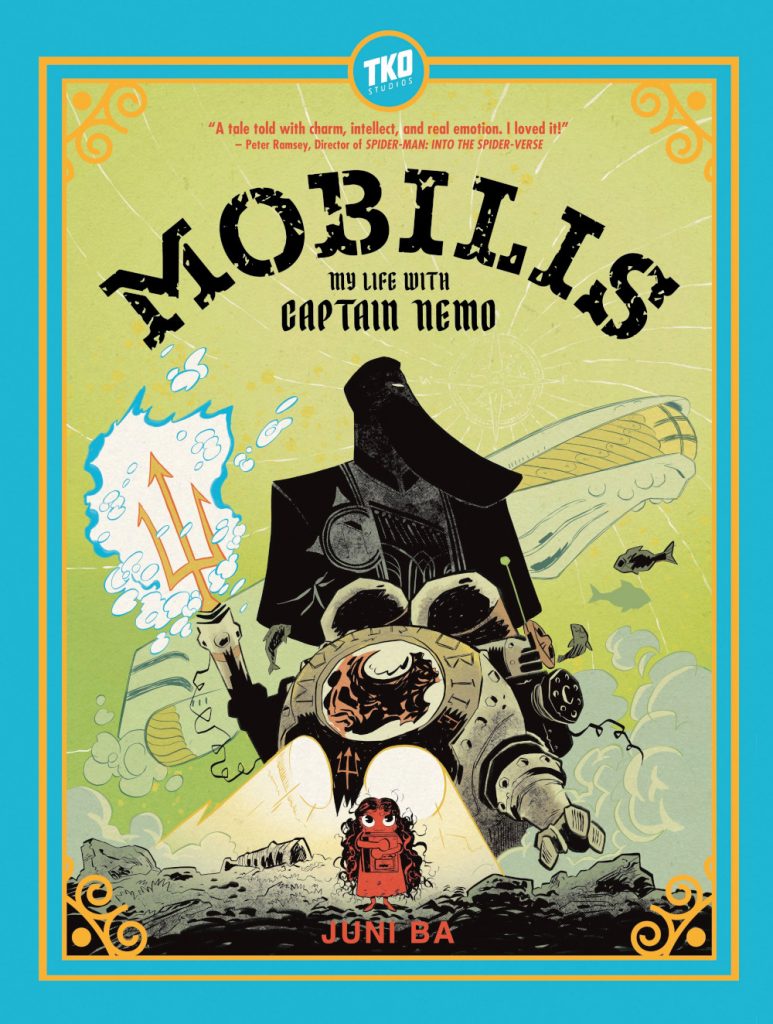
The Promises Kept Award: Mobilis
Why it stands out: While I’ve always appreciated cartoonist Juni Ba’s work, he’s such explosive idea person and such an energetic artist that his books could feel overwhelming to me as a reader. That’s not to say it was ineffective. It just felt like there was a step coming where Ba focused those ideas in a way that would maintain the energy and joy of the work while giving it a sense of clarity that would amplify the whole in the process. My thought was when everything came together, it would result in one heck of a comic, one that would floor everyone who read it.
That promise was kept with Ba’s graphic novel Mobilis: My Life with Captain Nemo. This story of an obsessive Captain Nemo, his young ward Arona, and the connection and differences that unite and separate that pair at the end of the world is a doozy, and it’s everything I hoped for from Ba and more. It still has all the ideas and personality we’ve come to expect from his work — shouts to Nemo introducing Arona to A Tribe Called Quest, a small thing that felt like a signature decision within the story — while being tighter and more focused than previous efforts. It also felt more personal, like a reflection of Ba’s pandemic experiences through the locked down environment of Nemo’s great ship, the Nautilus. It’s the cartoonist’s own take on Jules Verne’s Twenty Thousand Leagues Under the Seas, one that’s bursting at the seams with energy but in a way that maximizes impact and feels paced to elevate the emotions of the story to the absolute max.
While I described Mobilis as Ba’s magnum opus when he came on Off Panel recently, it’s worth noting that my suggestion is likely incorrect, if only because calling Mobilis that suggests he doesn’t have higher heights he can reach. My belief is he’ll just keep getting better from here, and one day, we’ll look at Mobilis as a great comic, but a turning point to even more transcendent heights for his work. We shall see. No pressure, Juni!
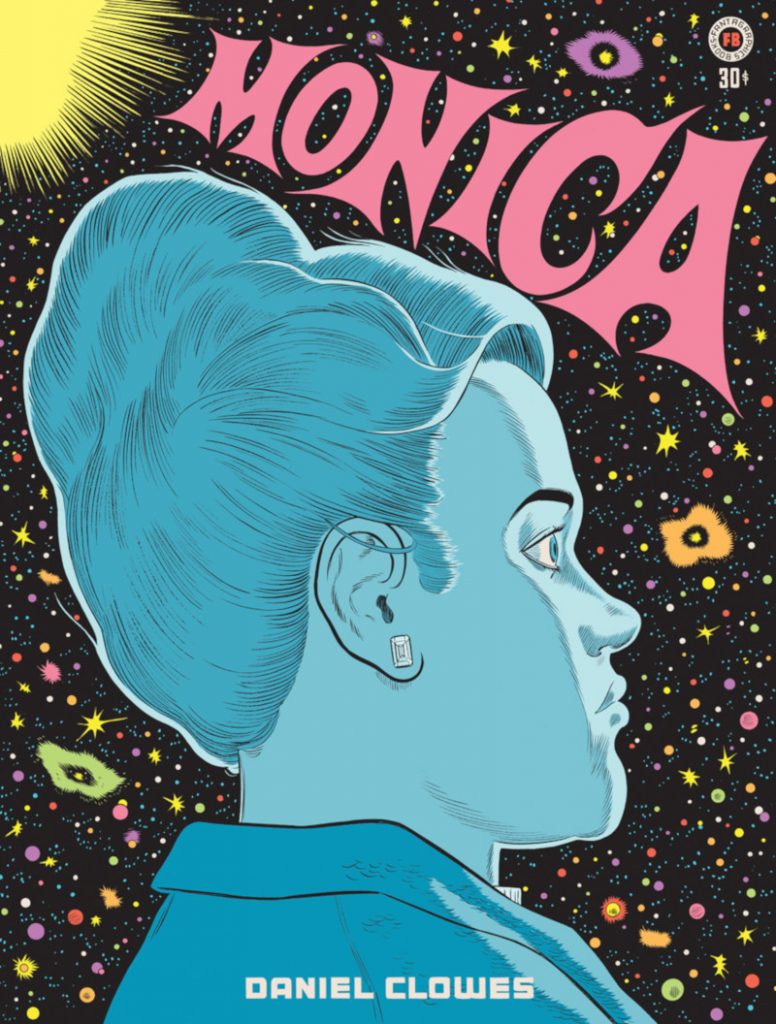
The Transporter Award: Monica
Why it stands out: Daniel Clowes’ Monica is a journey.
While it’s ostensibly about the titular character’s entire life being played out on the page, it’s much more than Monica. While she’s its most essential character, she’s more of the tie that binds it all together. Over its nine or so chapters — which take us to the Vietnam War, into a cult compound, through a place haunted by supernatural happenings, and more while presenting us with characters that include a grandpa trapped in a radio, a man that is also a tree, some all-time questionable hippies, and more — readers explore different times and worlds and situations, all of which connect and belong to the space, but constantly feel like otherworldly spaces. When I read Monica, I found myself gripped by and immersed in its pages, even as I relentlessly flipped back and forth between pages trying to ground myself in reality.
That may sound a little overwhelming. It’s not untrue. But I’ll tell you this: No comic from 2023 is better at transporting you to another place and time as you read it than this one. I know it’s a real shocker to compliment a deservedly acclaimed graphic novel by a legendary cartoonist like Clowes, but if the shoe fits. I’ll even go one step further and say this. I think this is my favorite of Clowes’ work! It’s an astonishing achievement, with each element — from the cartooning and coloring to the lettering and production — being top notch, all built around a story that’s massive and small at the same time. It’s a heck of an achievement, and one that’s unlike anything else I read this year.
Daniel Clowes! Good at comics! News at 11!
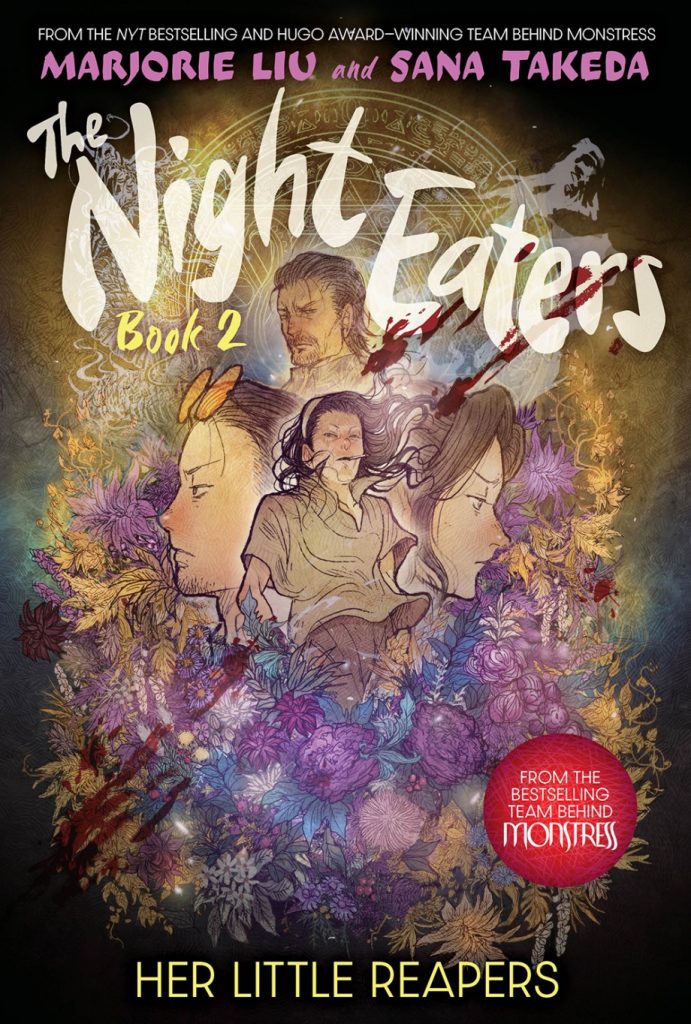
The Demons and Loving It Award: The Night Eaters Book 2
Why it stands out: I don’t share hot takes very often, but I have a hot take about Marjorie Liu and Sana Takeda’s The Night Eaters series. As you may know from my Comics of 2022 list, I was a rather big fan of the first volume. As you can tell from this one, I’m also a fan of the second volume. But something hit me when I was reading the second book. While it’s still a horror story and a family drama and a whole lot of other things, it’s also…a comedy?
I mean that sincerely. While the first book had funny moments in it, in-between the second’s moments of giant plot beats and intense face-offs between people of varying supernatural backgrounds, it actually can be quite hilarious. Much of that comes from the book’s leads in twins Milly and Billy (it’s really an ensemble, but they’re the de facto main characters of the story), a pair who just learned that they’re effectively demons and have been their whole lives and are now taking wildly different paths to understanding and appreciating that even if they’re spatially together. Billy in particular is a voicebox for Liu’s more comedic side, as he’s endlessly making you laugh out loud as he copes with (and gets excited by) their new reality. That guy lowkey, or maybe even highkey, loves being a demon. But that’s not my point. My point, and hot take, is this: The Night Eaters is a funny comic!
It’s also a lot more than that. The reason it’s easy to lose the comedic side of The Night Eaters is because it’s good at so many other things, from Takeda’s astonishing art and Liu’s tremendous character work to the complex nature of the supernatural world they’re setting up. This is a big story about big ideas. But it’s also about family and identity and trust and so many other deeply personal ideas. Honestly, it’s the most manga-like non-manga series on the market today, if only in how it weaves all these ideas together into a comic that makes you feel the full emotional spectrum throughout your read. The Night Eaters continued to impress with its second volume, and continued to do so in surprising ways, showcasing a pair of talents who still have room to surprise readers — and maybe even make them laugh in the process.
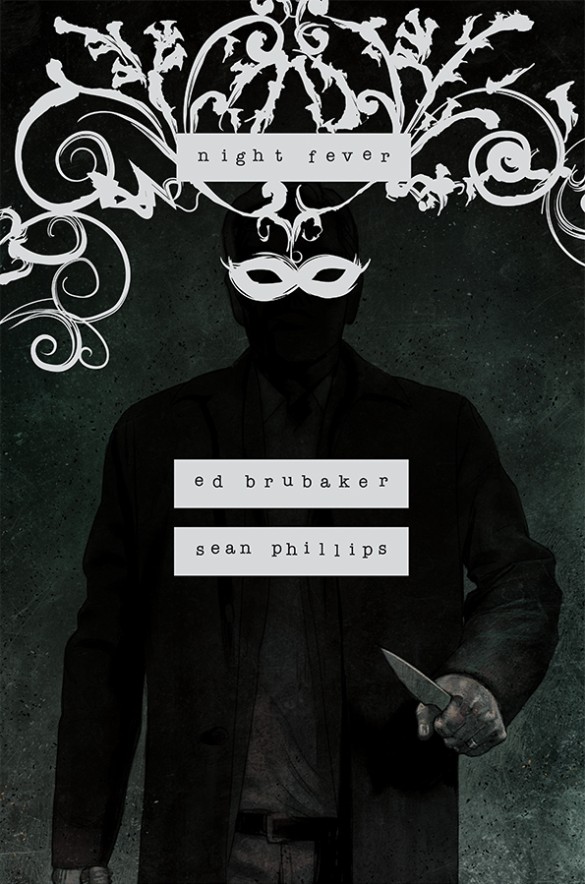
The “It’s Brubaker and Phillips(es)” Award: Night Fever
Why it stands out: It feels cheap to say that Night Fever is here because it’s a new graphic novel from writer Ed Brubaker, artist Sean Phillips, and colorist Jacob Phillips, but that’s a huge part of it. That team has established such a high bar for their work that just meeting it ensures they’ve made one of the best comics of any year they publish one in. Pair that with the fact that they’re outrageously productive — or, more specifically, Sean Phillips is, as he’s one of the few artists (and maybe only) that can produce multiple graphic novels in a single year and never see the quality of his art diminish — and you can effectively pencil any published work in for a SKTCHD AWRD each year.
But it’s worth noting that Night Fever, their first release this year, makes it while Where the Body Was, their most recent book, does not. That’s not because Where the Body Was happens to be lacking in some way. It’s a fascinating read that explores a neighborhood and all the individuals that make it unique, with all that orbiting a dead body that may or may not be enormously consequential to the story. It’s the pair experimenting with how they tell a story. It works well. But Night Fever doesn’t just work well. It’s a lightning bolt for this creative team, with all involved feeling energized in their exploration of their lead’s misadventures while he’s on a business trip in Europe.
It honestly feels like the team at their most unhinged, and I mean that in the best of ways. Jonathan, the book’s lead, is a disastrous, mess of a main a character, one you follow with gritted teeth and low expectations. That character takes us on a Before Sunset-like tour of a European city, except his guide isn’t the lovely Julie Delpy, it’s Rainer, a charismatic sociopath that might be on the Mount Rushmore of Brubaker/Phillips creations. As Jonathan gets deeper and deeper into a lie he’s created and a world he doesn’t belong to, reality quickly becomes tenuous and mistakes are made at a rapid rate — and with enthusiasm. It all just absolutely rules. I know that’s not a technical description, but this might be the apex of the “Dad fiction” that the Brubaker and the Phillipses have been crafting of late, and it’s difficult to not get absolutely immersed in its story because how much the team is rolling here.
While I wouldn’t say this story is of a completely different flavor than what we might expect of this creative team, its atypical locale and lead with an increasingly untethered connection to reality results in a book that is hard to deny, even inviting rereads to explore what’s real and what isn’t. It’s a dark book, but it’s a fun one in that typical Brubaker and Phillips way, while having a little je ne sais quoi that separates it from the rest.
I talked with Brubaker about this book earlier this year on Off Panel, if you’d like to hear us dig a little further into it.
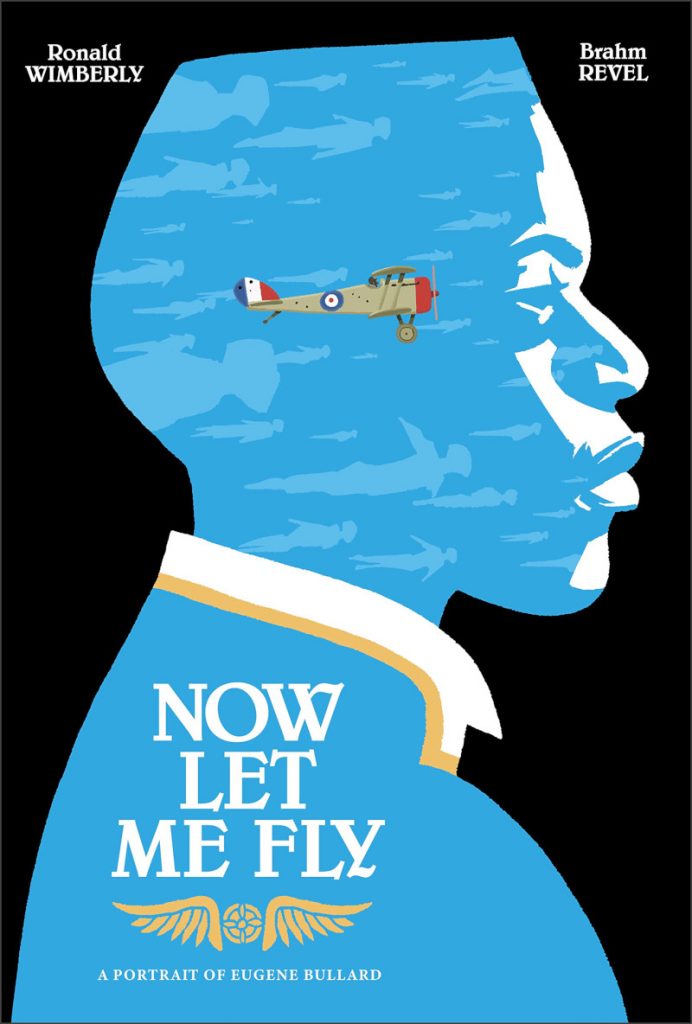
The Late Breaker Award: Now Let Me Fly
Why it stands out: Here’s a funny thing about my process for these awards. I actually received Now Let Me Fly, Ronald Wimberly and Brahm Revel’s portrait of pilot and renaissance man Eugene Bullard’s life, in 2022. I didn’t read it then, because I was prepping for my Comics of 2022 awards. But with this graphic novel being released just three days into 2023, its advance copy came while I was in the consideration process for last year. That’s why I almost forgot to read it as I was prepping for 2023’s awards. It existed in a space in my head that was both last year and this one!
It was one of the last comics I read as I was finalizing my list, and as soon as I finished it, I announced to my wife that it was a real contender. That was for three main reasons. One was its writer, Ronald Wimberly, one of the smartest, most incisive and inventive storytellers in comics. The way he crafts and cultivates this exploration of Bullard’s path to becoming the first African-American fighter pilot is impressive, and a lovely way to highlight the type of person Bullard was. Another was its artist, Brahm Revel, a Creators of 2023 award winner and someone whose cartooning is incredible as it is underrated. Lastly, we had Bullard himself. That man was so tremendous I could spend an hour telling you about his life and it would be time well spent. But when you have two master storytellers at the wheel instead, you’re given a tour de force that’s equal parts thrilling, entertaining, and poignant.
As a showcase for those three incredible people, Now Let Me Fly soars, delivering as both a respectful biographical comic and as an entertaining character study. You don’t read abut Bullard’s journey as much as you live in it, offering a portrait into the life of a truly remarkable man.
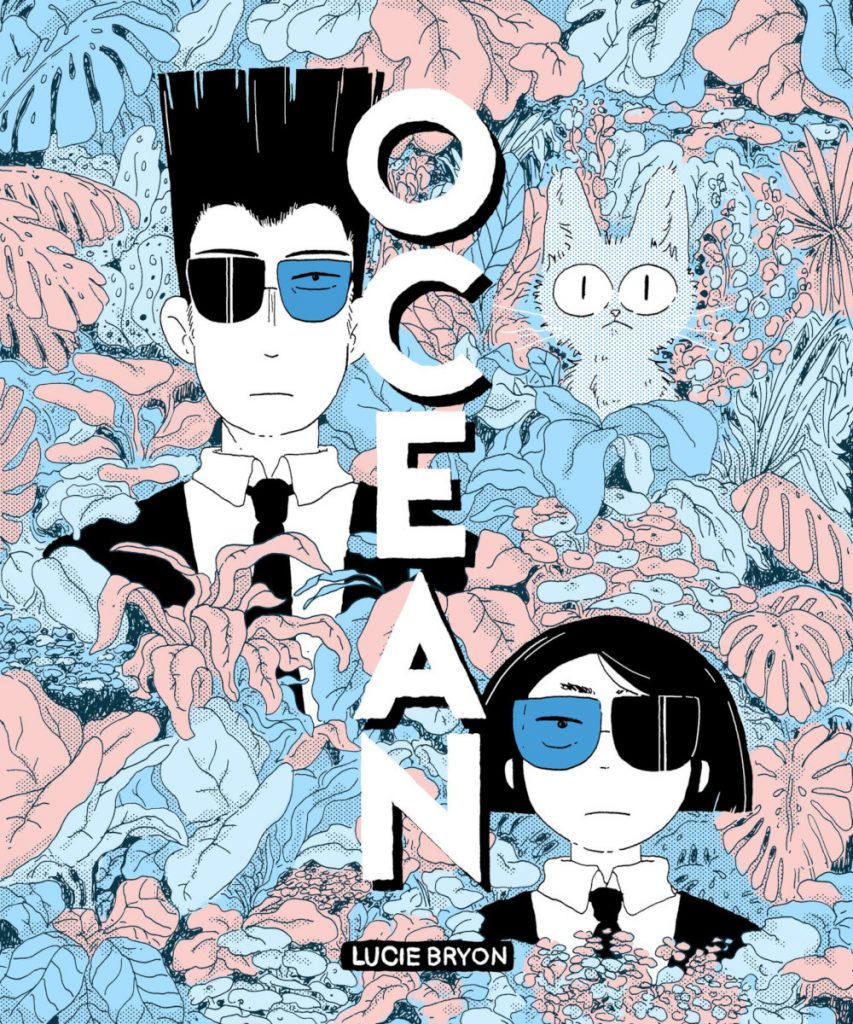
The Comic of the Year Award: Ocean
Why it stands out: While there are a lot of reasons that cartoonist Lucie Bryon’s ShortBox Comics Fair entry, Ocean, was my favorite of the year — many of which speak to Bryon’s gifts as a cartoonist, which are prodigious, unique, and wonderful — the biggest comes down to this: I knew it as soon as I read it. There’s something intangible to a comic you really love, a characteristic you feel more than you think. Something that hits you as you read it and you just know, “This is something special.” Not every Comic of the Year Award winner in The SKTCHD AWARDS has had that little extra something, but Ocean? It was a comic entirely made of that feeling, where every moment and decision on the page reinforced that this wasn’t just a good comic, but my absolute favorite one of the year.
This 75-ish page comic is about Toots and Boots, a pair of Time Paradox Agents who go on a mission to track down a displaced time traveler causing chaos in a lovely town in France in the year 2000, only to get stuck there when the device that guides their travels breaks. The pair is faced with a situation where they have to figure out how to live an ordinary existence in a time much different than theirs, and this story explores what comes from the experience of doing that. And it is so, so wonderful. Inspired by a sign Bryon saw in the United Kingdom for a hairdresser called Ocean that featured two characters who looked quite similar to this pair, this is a tour of how that duo becomes hairdressers and learns that maybe living life isn’t so bad. More than that, it’s a demonstration of Bryon’s brilliance as a storyteller, as this comic is a non-stop showcase of her genius through decisions both big and small.
That comes in a lot of forms. Those include: Using the look and words of a Wikipedia entry in Toots and Boots’ time travel device! The color choices throughout! Playing with reader expectations about Toots and Boots based on their look! An incredible face she gives the nefarious time traveler as it faces the warm sun! Far and away the single best page turn of the entire year! While much of my adoration of this comic comes down to how much I enjoyed living in the story and getting to know these characters, Bryon’s gifts as an artist and a writer are truly rare. She’s someone who can turn a graphic novella into a highlight reel for her talent.
Here’s another example of how much I loved this comic: I’ve already read it three times. It was a joy to read the first time, but it’s irresistible enough that I keep revisiting it and finding more to love. That’s the sign of a great comic. Ocean is a wondrous one, and an easy pick for my Comic of the Year.
As a programming note, Bryon’s my guest on Off Panel next week, and in it, we discuss Ocean’s future as something you can read. Because Ocean was a ShortBox Comics Fair release, it was only available for purchase in October, so you cannot actually read it right now. But it may live on! You can learn about that in next week’s podcast.
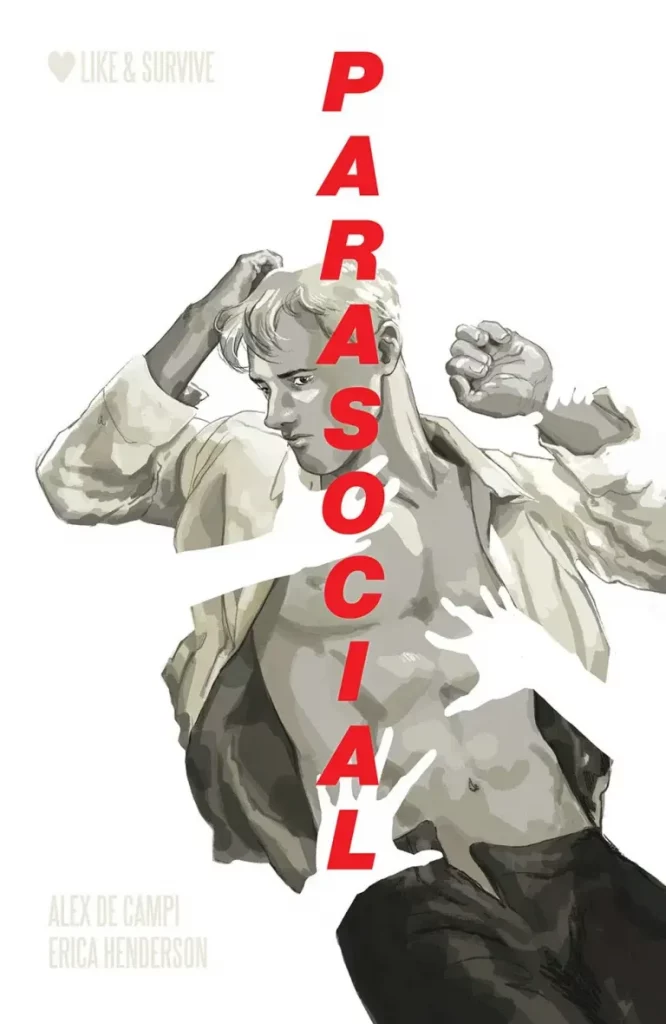
The Misery Loves Company Award: Parasocial
Why it stands out: Parasocial’s easiest comp for readers is Misery, the Stephen King novel turned James Caan/Kathy Bates starring thriller. The parallels are easy to make. Both feature a notable person of some variety that was helped by a fan in a time of need, only for that situation to quickly turn for the worse. In Parasocial’s case, it’s a former genre TV star in Luke Indiana finding himself tied up in the home of his superfan Lily after a day at a comic convention in the area, as the two square off for much of the book in a battle of wits, will, and emotion in a tense showdown in her home.
That makes the Misery comp add up, but to be honest, it’s an oversimplification in my mind. Where Parasocial thrives is in the fact that unlike Misery, neither character is a clear villain or hero. There’s the legal right and wrong of it, but there’s also the fact that Indiana is a nightmarishly selfish individual. You don’t root for anyone. You just watch the situation play out with fear in your eyes and your heart — even as you’re riveted thanks to the remarkable craft of its creative team — as it seems destined to end with a bad result for all involved. That makes it a much different and more complicated read, as do the modernized wrinkles to it, like the role of social media and the way that things like that and convention-based interactions can create belief in something that isn’t there. Writer/letterer Alex de Campi and artist Erica Henderson turn this two-hander into an incisive, often quite funny thriller that’s hard to resist, even if it does make me question every convention experience I’ve ever had.
But I want to reemphasize something from last week’s Creators of 2023 awards: There’s a reason I named Henderson my artist of the year, and a big part of that is what she does in Parasocial. While de Campi and Henderson are an incredible, proven pair, one that clearly is in sync in how to make this book look as good as humanly possible, Henderson’s choices throughout astonish. Whether it’s the distressed feel to flashbacks, the color choices throughout and how they display and control mood, or the character acting that helps us see what Lily sees as Indiana lies through his big dumb handsome teeth to try and manipulate her, Henderson is a house on fire throughout Parasocial. Pair that with de Campi’s stellar script and lettering choices, and you have a path to one heck of a comic — one of the best of the year, even.
I talked with both Henderson and de Campi about this comic on Off Panel, albeit separately. Both are well worth a listen, if you feel so inclined!
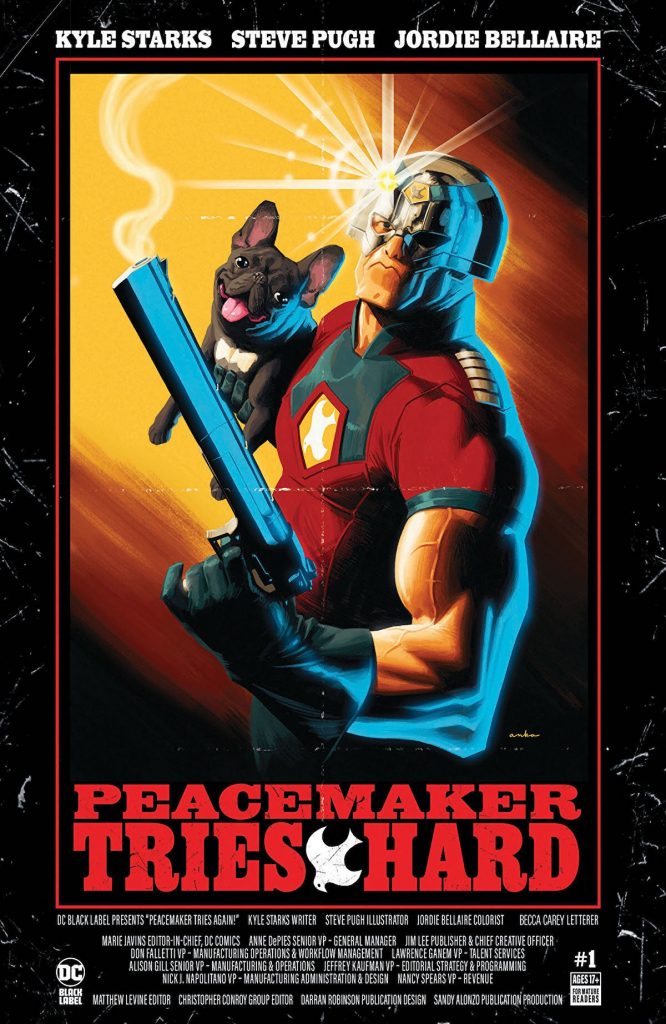
The Squad Goals Award: Peacemaker Tries Hard!
Why it stands out: What is Peacemaker without the Suicide Squad? Well, it turns out he’s pretty much the same as he always is, because Peacemaker largely comes in one flavor: big, dumb, violent, surprisingly emotionally wounded, and desperately in need of friends. That’s a high variance character, one that could result in greatness — see: James Gunn — or in being forgettable (see: most of the character’s history). That’s why the character is always in need of a good squad. But I don’t mean one of the Suicide variety. I mean a creative team, like the one behind Peacemaker Tries Hard! in writer Kyle Starks, artist Steve Pugh, colorist Jordie Bellaire, letterer Becca Carey, and cover artist Kris Anka. In a lot of team’s hands, Peacemaker is a 90s fever dream, one that we’ve all read and moved on from before. In this one’s mitts, though, Peacemaker is our guide to an entertaining and surprisingly poignant tour of the DC universe, and one of the best single-issue titles of the year.
Peacemaker Tries Hard! always seemed destined to be a likely success. Starks fits the character like a glove, with an approach to character and story that meshes nicely with Gunn’s takes. Pugh’s quietly one of the great artists in comics today, capable of big emotion, laughs, and action at the drop of a hat. Bellaire’s a perfect complement, someone who can bring the most out of any moment with her colors. Carey’s an ace, someone who always seems to know the right answer for each book and situation. And Anka’s the secret sauce, someone whose covers are a tonesetter from a vibe standpoint. This should have worked, and it did. But it worked even better than expected.
In fact, in a just world, this should be a comic you could easily hand off to fans of Gunn’s version of the character and say, “Hey, you want more stories like that? How about this one?” and it would just work. We’ll see if that ends up happening, but this team managed to craft a tale that’s deeply ridiculous in the way we’d hope a Peacemaker story would be — it involves any number of C-list characters and lower, as well as a central mission focused on rescuing a dog named Bruce Wayne — but also heartfelt and emotionally honest in unexpected ways. It’s an 80s action adventure that wears its heart on its sleeve, and it thrives thanks to that set up, as well as the wondrously talented creators telling this tale.
I talked with Starks about this book on Off Panel earlier this year, as well as a whole lot of other things.
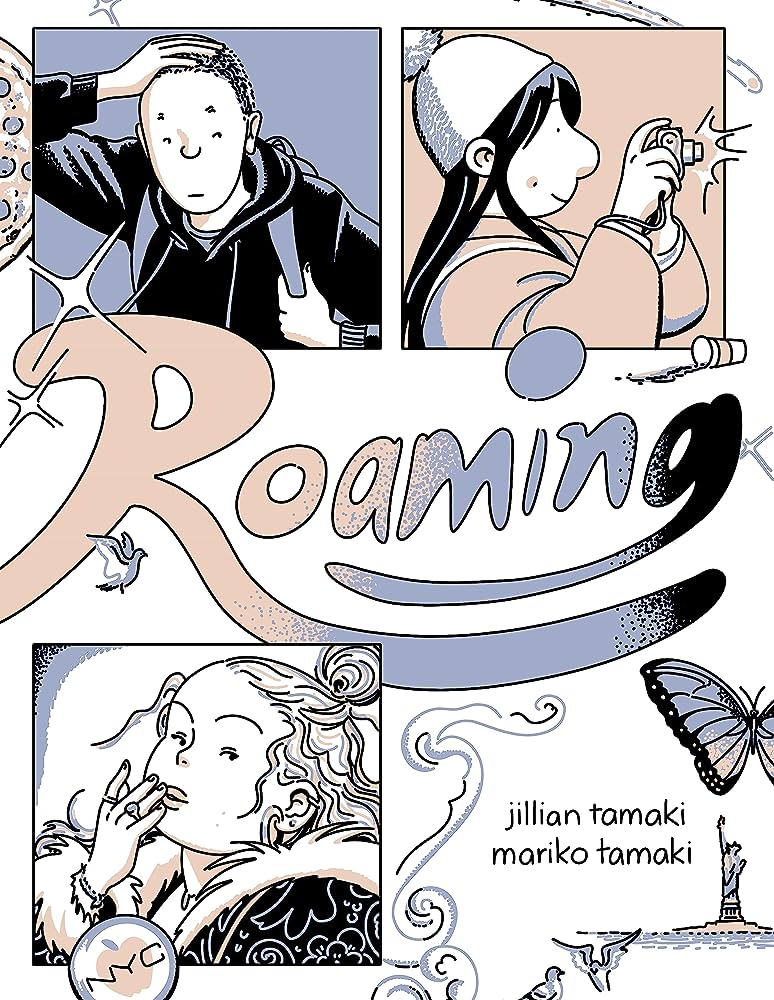
The Universal Award: Roaming
Why it stands out: The latest graphic novel from Jillian Tamaki and Mariko Tamaki was a much awaited one. And for good reason. That pair crafted one of the most successful and renowned comics of this century in This One Summer, and individually, they’ve proven themselves as giants in the industry. Together or separate, they thrive, but we’d only ever seen two collaborations from them in This One Summer and Skim. For that reason, Roaming was deservedly at the top of many most anticipated lists, as we all wanted to see what else they had in their bag.
And you know what?
It turns out they still got it!
There are a great many things I loved about this book — whether it’s Jillian’s remarkable cartooning and character work, Mariko’s fully-realized characters and sharp dialogue, or the choices that fit somewhere between the both of them, like some scenes taking a breath to let a moment simmer or just let us observe the environment — but maybe the thing that impressed me the most was how universal this story felt. There’s a version of this graphic novel that doesn’t work quite as well because the characters are too archetypal or not fleshed out enough or just feel like marionettes playing out a drama. Each character in this book needed to feel real for us to be able to empathize with their situation while also being able to see ourselves in it, connecting even further in the process.
And the pair got there, and then some, in Roaming. That’s made a bit easier for someone like me who took a very similar trip to New York City by train for spring break in college that resulted in disaster, as the one in this book did. But it’s less about specificity and more about the complexity, energy, and mistakes of youth, and what we do when faced with them in tight, almost inescapable confines. It’s a coming-of-age tale, one with real bite and specificity to it that feels authentic in a rare way. Roaming is a slice of life, one that contains all the flavors — both good and bad — just like our real existences do, and the pair behind it never ceases to impress with their observations and artfulness in depicting this journey.
Roaming isn’t This One Summer. It might not even be what you expect. But it’s still a triumph, and another example of why this pair — together or individually — are two of the finest creators working in comics today.
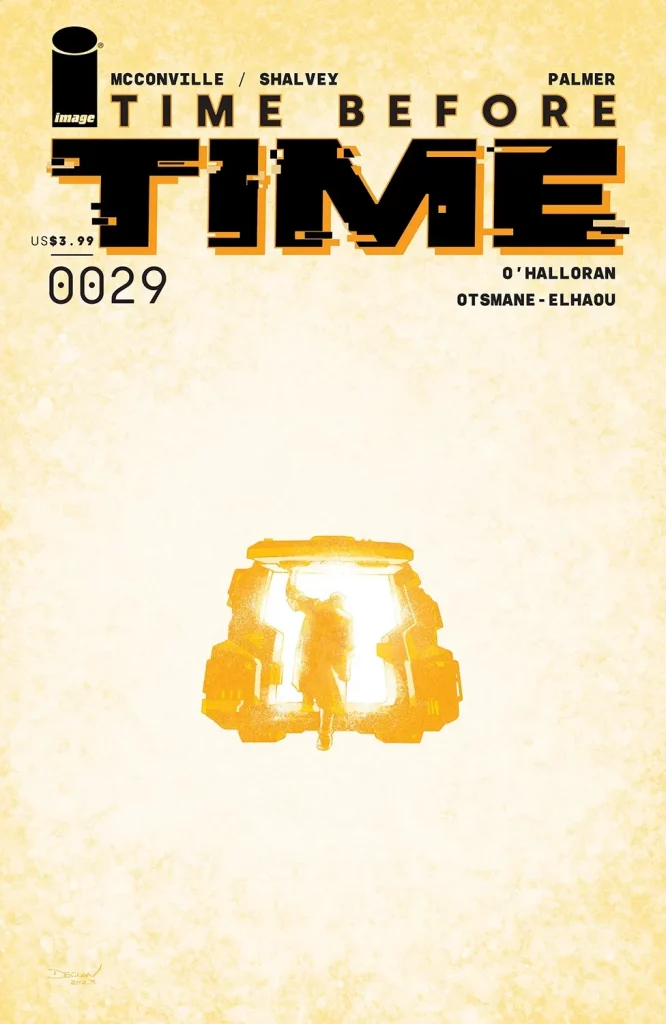
The Slow and Steady Award: Time Before Time
Why it stands out: Based on my count, only 17 of the 86 comics that were released this past Wednesday were numbered 10 or higher. This is an exercise I’ve taken on several times lately, both because of what I do here on the site and because I’m a loon. But I can tell you this: that ratio is likely a little higher than average. Most comics just don’t run for that long. Double digits are a dream, one few ever get to live up to in this, our year of 2023. And without that extended run, two things are limited. One is your ability to tell a story to its ideal length if you’re a creator. Another can be the length necessary to get fully invested in a story if you’re a reader. It’s hard to build connections in five issues or fewer, both as a creator and as a reader. But time is a precious resource these days, and one most comics just do not have at their disposal.
Maybe that’s why it feels so fitting that Time Before Time — an Image series from co-writers Rory McConville and Declan Shalvey, an assortment of artists that include Joe Palmer and Geoffo, colorist Chris O’Halloran, and letterer Hassan Otsmane-Elhaou — didn’t make my list until its third year. This series was solid in its first year back in ye olden days of 2021, good in 2022, and took a real leap in 2023 when issues #19 to its finale in issue #29 hit. And it wasn’t even necessarily that the series was markedly different than it was before, as all the exceptional character work, strong art, and everything else that made this series work had been there since the beginning. It’s possible it was just that Time Before Time lived long enough for me to get fully invested in the journey of its three leads in Tatsuo, Nadia, and my guy Kevin, an endlessly entertaining robot, which allowed me to recognize the series for what it always was: an excellent comic, and one of the strongest Image titles of the past five years or so.
It’s fitting that Time Before Time, a comic about a trio of time travelers on the run throughout a period of time spanning thousands of years, benefited from an unusually lengthy run. No series better recognizes how precious of a resource time is than this one, and its story popped because it was allowed that space. By the time it reached its finale, a lovely, thoughtful, and atypical read that closed the door on each character’s journey in a way that was only possible for this series, it was peaking rather than falling, showing that if given time and space, a good comic could become a great one — or even something more.
I talked with Shalvey about it on Off Panel a little while back, amongst a number of other things.

The Endless Surprise Award: w0rldtr33
Why it stands out: w0rldtr33 is an Image series from writer James Tynion IV, artist Fernando Blanco, colorist Jordie Bellaire, and letterer Aditya Bidikar, one that’s about a malevolent internet that exists beneath the known one, and the impact it has on society and the group of people inextricably linked to it. Knowing that creative team and concept, it shouldn’t be a surprise that it ends up on this list. It’s an A-list team taking a big swing, one that wears its love of disparate interests like Stephen King’s It and Wildstorm comics from the late 1990s and early 2000s on its sleeve. What’s not to like?
While some of it is familiar and expectedly great, what makes w0rldtr33 work as well as it does, though, is how its creative team has taken these flavors and turned it into something new and surprising. That last word is one of my favorite things about this book: it’s always keeping me on my toes. Whether it’s an unexpected relationship, a time jump that comes out of nowhere, or characters that come and go just as we’re getting invested in them, this series treats nothing as sacred. Anything can change at any given moment. It’s a much more thrilling read because of it. In its first arc, w0rldtr33 established itself as one of Image’s strongest debuts of late, and one with the potential to take readers on a real journey. Like with Time Before Time before this, I hope Team w0rldtr33 gets the room to run, because the potential is enormous — think all-time great — if they do. Fingers crossed, because this one’s a gem.
Given that I’ve interviewed Tynion 12 times in the past 12 months, it will not surprise in the slightest to learn we discussed w0rldtr33 this year — both on Off Panel and on SKTCHD. But if you’re interested in this series, we dig into it there at great length.
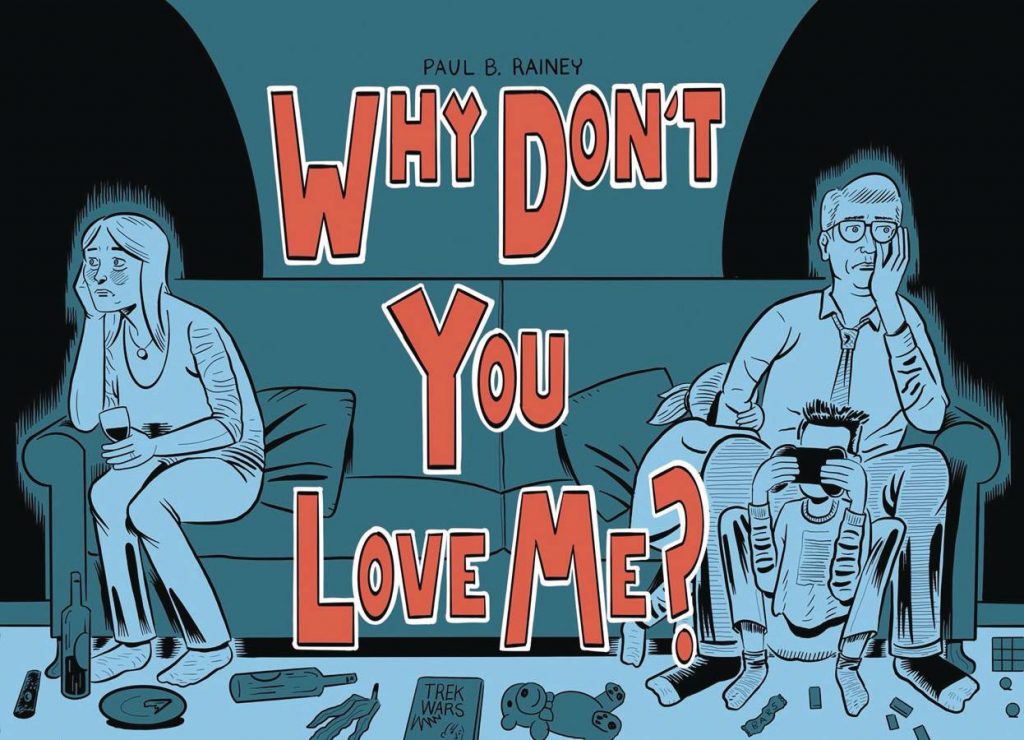
The Keep At It Award: Why Don’t You Love Me?
Why it stands out: Paul B. Rainey’s webcomic turned graphic novel Why Don’t You Love Me? found me dangerously close to putting it down for good early on in my read. Its open and introduction to its misanthropic leads is a lot to take, as it feels like a classic indie comic with characters that seem real while also being tremendously unlikeable. Strip after strip — this comic is told as a series of comic strips that form a larger narrative — I grated at the horrific couple at the head of the story and their outrageously poor handling of their children. But with each passing strip, you start to understand that everything is not as it seems, even as these character continue to send their children off to buy them wine or refuse to send them to school out of sheer laziness. Your understanding expands, and slowly but surely, this comic turns from a study of ne’er-do-wells ne’er-do-welling to something that bridges the gap between science-fiction and adult relationship drama…while still having one foot in that ne’er-do-well hole.
In fact, if you split it up in, let’s say, 60 page chunks, it basically is structurally the same as that famous Vince McMahon meme. Early on you’re making your way through it as you start to get a feel for what’s going on. Then, you’re getting invested in what’s going on, trying to figure things out as the characters themselves do the same. When the latter half hits, what you know is torn away from you, and a reset hits that recontextualizes everything that spices it up even more. It’s laser eyes time by the end, with a complete flip from where you were in the beginning. Early on, you can’t imagine how you’ll continue reading; by the end you want nothing more than to do so.
It’s honestly one of the most astonishing and surprising comic works of…the past decade? It isn’t my favorite comic of the year, but it is maybe the most unique, as Why Don’t You Love Me? is a singular work that completely blew me away. Now, I’m deliberately saying as little as possible, because part of the joy of this frustrating, poignant, smart, stupid, hilarious, and gut-wrenching read is figuring out what’s happening as it’s happening. But I’ll give you the same bit of advice I could have used when I was first reading it: keep at it.
Because it’s worth it.
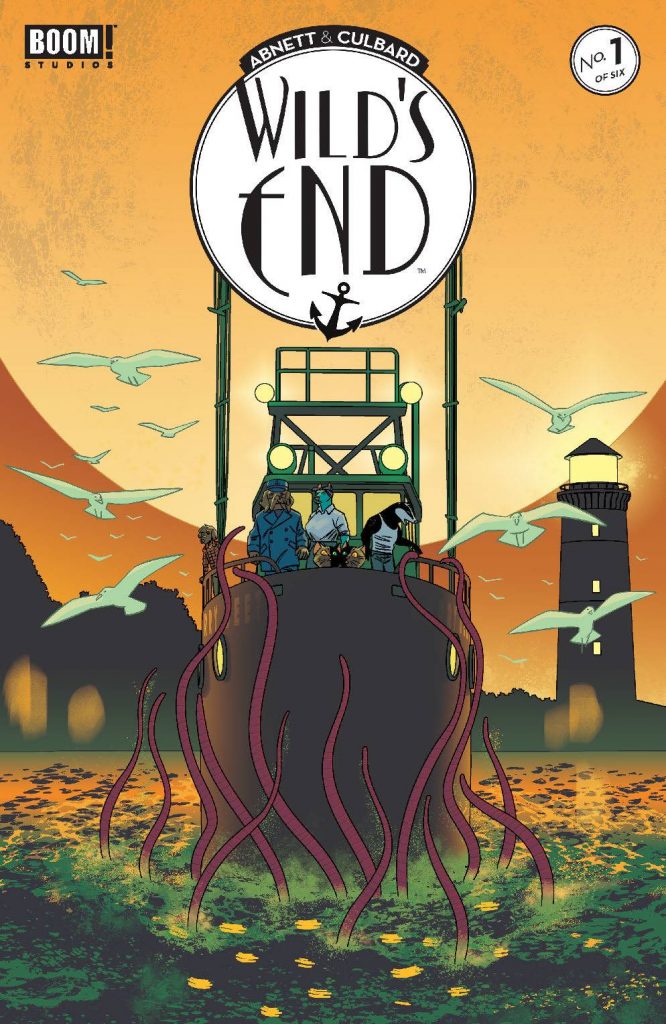
The “I Will Continue to Tell You to Read Wild’s End Until You Comply” Award: Wild’s End
Why it stands out: If there’s one thing I’m known for, save for my adoration of Stilt-Man, it’s how I endlessly rep for titles that don’t get as much love as I believe they deserve. Zander Cannon’s Kaijumax is probably the most famous of the lot. But if it’s the 1a of that list, Dan Abnett and I.N.J. Culbard’s Wild’s End is the 1b. This series about anthropomorphic animals trying to survive an alien invasion in the British countryside has long been a favorite, as its first three volumes took us on a complete journey following a small group of characters making their way through that situation. It easily, and deservedly, made the version of The SKTCHD AWRDS that celebrated my Comics of the Decade for the 2010s.
So, when BOOM! Studios announced that Abnett and Culbard would be returning to this series with a new volume exploring the invasion with a different cast of characters in a different situation, you can imagine I was excited. And you know what? It lived up to my expectations. The new cast was as lovable and easy to root for as the first. Abnett’s plotting and dialogue was as inviting as ever. Culbard made my Creators of 2023 list for his work here, as his work drawing, coloring, and lettering this series is world class, as well as this title’s beating heart. Despite the fact that they were effectively telling the same story again from a new angle, it felt as fresh and thrilling as the first time. I could keep going with new angles on this story from this pair forever. But in its latest volume, Wild’s End proved that it exactly what it always was: one of the best single-issue series going, and one that should not be missed in any incarnation it arrives in.
But I have told you this. That’s why this award is simple. Wild’s End is incredible. If you have not read it yet, you’ll soon have no excuse. A collection of the first three volumes arrives next month, with the one touted here hitting in April. Its complete story — for now — will be readily available in the first half of 2024. If you’re a fan of comics, treat yourself to greatness and read Wild’s End, because you, and that series, deserve it. Oh, and if you think this is the last time I will remind you to do just that, you’re obviously mistaken. More Wild’s End hype will be coming in the new year, assuredly.
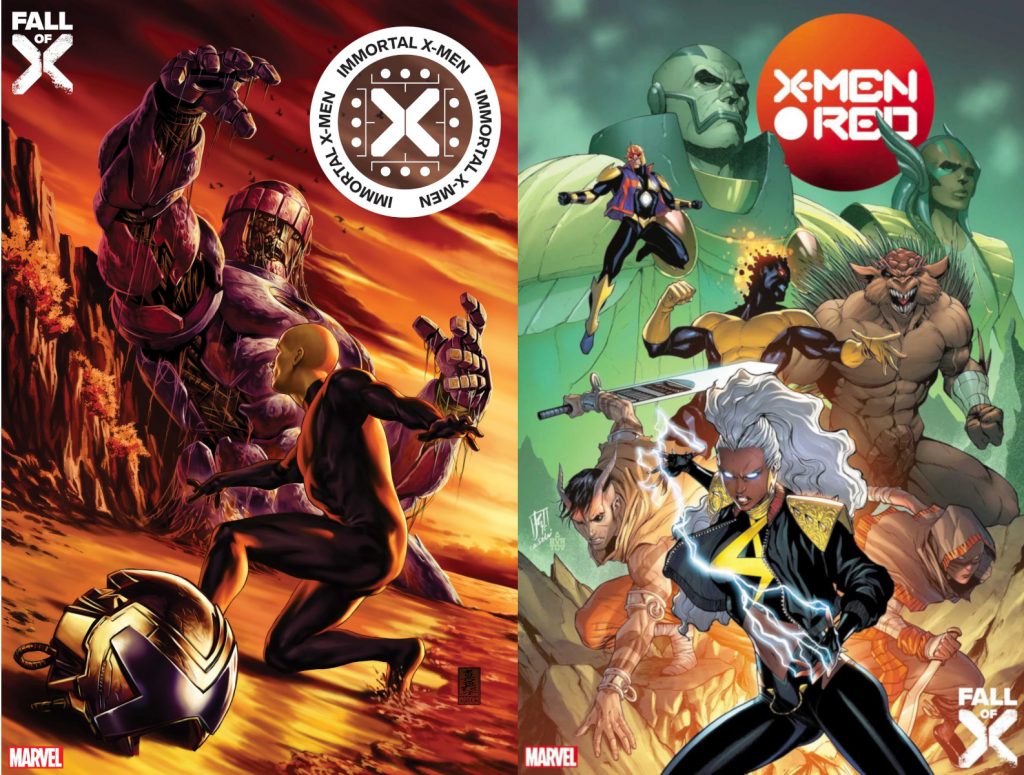
The Two That Are One Award: Immortal X-Men/X-Men Red
Why it stands out: Is part of the reasons I paired these comics together because I wanted 26 comics on this list, not 25? Maybe. But just because one thing is true doesn’t make others not, and ultimately, Immortal X-Men and X-Men Red are two comics that will forever be connected in my mind. They’re two sides of the same coin for the latter half of this era of the X-Men, one that’s about the order (and the chaos) of Krakoa through the prism of its Quiet Council and another that’s about the chaos (and the order) of Arakko as seen in the machinations of its equivalent group in the Great Ring. So much of their events feel connected and even like a reflection of one another, whether it’s the impact of secrets versus a direct approach, holding power versus building something together, and perhaps more importantly, trying to survive versus finding a way to thrive.
This all makes sense, and is likely intentional at least to some degree, as writers Kieron Gillen (Immortal) and Al Ewing (Red) overlap in sensibilities and talk about their overall arcs fairly often, even collaborating for 2023’s Sins of Sinister crossover with these books (or, rather, their brief replacements in Immoral X-Men and Storm & the Brotherhood of Mutants). They’ve also existed at maybe the most uneven time of the Krakoa Experiment, both for the mutants and the people guiding them. But through these two titles, this line’s mind and heart have been on display throughout, acting as an inseparable pair that defined the past couple years of the X-Men for me as a reader — and did so together. That’s worth celebrating, even if I did have to sort of cheat to get there.
